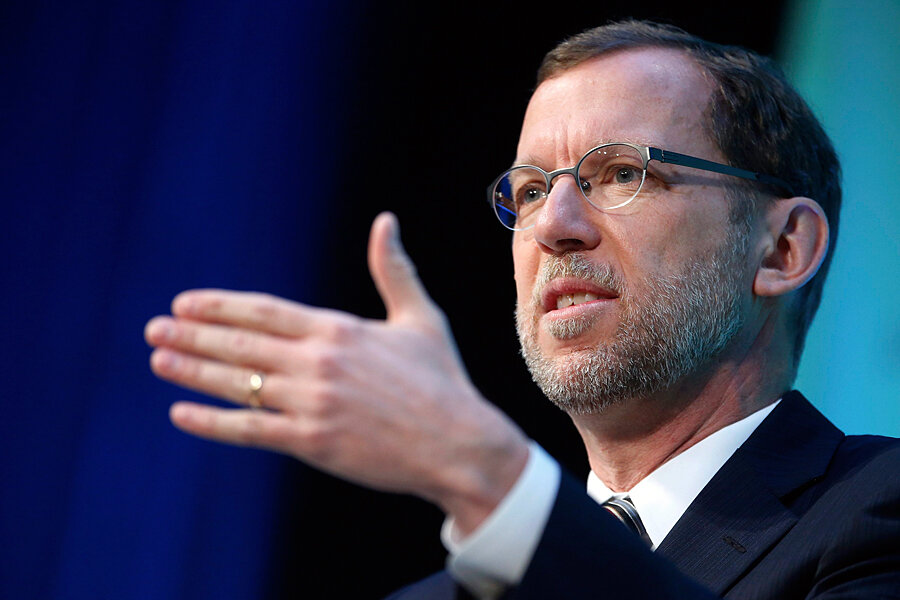National debt will exceed entire annual US output by 2039, CBO projects
| Washington
Americans, your government is getting larger, and the debt you shoulder as taxpayers is going up.
That’s the message embedded in the latest “Long-Term Budget Outlook” reported annually by the Congressional Budget Office.
The CBO slices and dices the numbers various ways, but the overarching conclusion is that federal debt is on a rising path – a track that poses risks to the economy.
“[F]ederal debt held by the public is projected to grow faster than the economy starting a few years from now, and because debt is already unusually high relative to GDP, further increases could be especially harmful,” says the report, prepared by CBO staff that’s led by director Douglas Elmendorf.
Central numbers from the forecast:
• Public debt is on track to grow to an amount equal to 78 percent of one year’s gross domestic product (GDP) by 2024 and more than 100 percent of GDP by 2039. That compares with its level of about 74 percent of GDP today.
• Short-term improvement in federal deficits isn’t changing the long-term picture. The CBO sees the deficit – the gap by which federal spending exceeds revenue – declining to an amount below 3 percent of GDP in the 2015 fiscal year. The pace of health-care inflation has also slowed in recent years. But later in this decade, the rising costs of entitlement programs like Social Security and Medicare push deficits higher.
• Federal spending is on track to rise to 26 percent of GDP by 2039 under the status quo assumptions of the CBO’s “extended baseline.” That compares with an average of 20.5 percent over the past four decades. The driver is those entitlements. Spending on discretionary programs is projected to be 7 percent of GDP in 2039, down from about 11 percent in the past four decades.
• Tax revenue will also be rising, but not as much as spending. Revenue would equal 19.5 percent of GDP under the extended-baseline forecast, compared with 17.5 percent of GDP in the past four decades. That rise in revenue would be fueled partly by people migrating into higher tax brackets and also by features of President Obama’s Affordable Care Act (such as an excise tax on some high-premium health insurance plans).
The report’s baseline view shows how the overall size of the federal government is poised for continued growth, relative to GDP – whether that growth is measured in spending or taxes.
But the CBO, as a nonpartisan accounting arm of Congress, does not take a stand on whether that’s a good or bad thing.
The debt is a separate issue. It represents the ongoing mismatch between spending and tax revenue, and Mr. Elmendorf and his colleagues argue the rising debt is unequivocally a bad thing over the long term.
That’s because, in general, high debt levels will tend to draw money out of private-sector investment, lowering the growth of GDP and personal incomes. High debt will also tend to push up interest rates, reduce global confidence in the dollar, and give policymakers less room to maneuver in a financial crisis.
“To put the federal budget on a sustainable path for the long term,” the report says, Congress must find ways to restrain entitlement spending, raise more tax revenue, or adopt “some combination of those approaches.”
The size of the needed shifts is significant.
To put the debt on a path back down to its long-term average of about 39 percent of GDP, spending (other than on debt interest payments) would have to fall by about 14 percent – or taxes raised by 13 percent. The shifts could be smaller if a mix of the two approaches were taken or if Congress didn’t try to reduce the debt that much.
The CBO analyzed various scenarios beyond the status quo baseline.
Debt could soar even faster (to 180 percent of GDP by 2039) if certain tax breaks and other policies that are set to phase out get extended. Or debt could fall back toward its long-term norm (reaching 42 percent of GDP by 2039) if Congress enacts about $4 trillion in deficit reduction through 2024.
The CBO also says the debt level could vary considerably if its assumptions about things like economic productivity, longevity, or interest rates prove to be too high or too low. The report doesn’t try to factor in uncertainties such as possible wars or the risk of an economic depression.
But the report says its basic message on debt “applies under a wide range of possible values for some key factors that influence federal spending and revenues.”
The sooner Congress acts to control the debt buildup, the easier the task will be, the CBO says. But some phase-in of changes might be wise because “if lawmakers implemented spending cuts or tax increases quickly, people would have little time to plan and adjust to the policy changes, and those changes would weaken the economic expansion during the next few years.”







